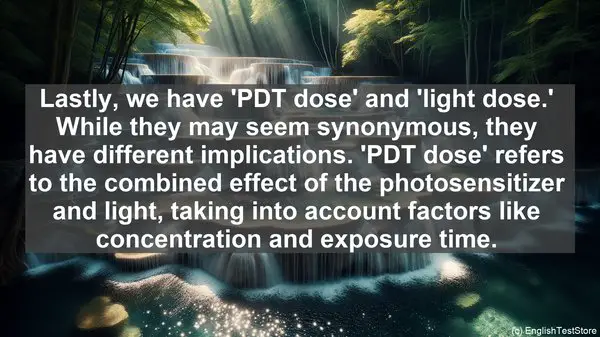Introduction: The Importance of Accurate Terminology
Welcome to our lesson on the top 10 commonly confused words in photodynamic therapy. As with any field, precise terminology is essential in photodynamic therapy. Misunderstanding or misusing a word can lead to serious consequences. So, let’s dive into these words and enhance our understanding.

1. Photosensitizer vs. Photosensitization
The first pair of words that often causes confusion is ‘photosensitizer’ and ‘photosensitization.’ While ‘photosensitizer’ refers to a substance that absorbs light and produces a reactive form of oxygen, ‘photosensitization’ is the process by which this reactive oxygen species damages cells. So, the former is the agent, and the latter is the action.

2. Fluorescence vs. Phosphorescence
Next up, we have ‘fluorescence’ and ‘phosphorescence.’ Both terms describe the emission of light after the absorption of photons. However, the key difference lies in the duration of this emission. Fluorescence is almost instantaneous, while phosphorescence has a longer-lasting emission due to the involvement of ‘triplet states.’
3. Singlet Oxygen vs. Superoxide
Moving on, let’s clarify the difference between ‘singlet oxygen’ and ‘superoxide.’ Singlet oxygen is an excited state of molecular oxygen, while superoxide is a reactive oxygen species. While both are involved in various photodynamic therapy processes, their reactivity and mechanisms of action differ.
4. PDT vs. PTT
In the realm of treatment modalities, ‘PDT’ and ‘PTT’ are often used interchangeably, but they have distinct meanings. ‘PDT’ stands for ‘photodynamic therapy,’ which utilizes light and a photosensitizer, while ‘PTT’ refers to ‘photothermal therapy,’ where light is used to generate heat and induce cell death.
5. ROS vs. RNS
ROS and RNS are two important types of reactive species. ‘ROS’ stands for ‘reactive oxygen species,’ while ‘RNS’ refers to ‘reactive nitrogen species.’ Both play significant roles in photodynamic therapy, and understanding their specific actions is crucial for optimizing treatment outcomes.
6. Irradiance vs. Radiance
When it comes to light, ‘irradiance’ and ‘radiance’ are often confused. ‘Irradiance’ measures the power of light incident on a surface, while ‘radiance’ describes the power emitted or reflected by a source. So, one is about incoming light, and the other is about outgoing or reflected light.
7. Photobleaching vs. Phototoxicity
Photobleaching and phototoxicity are two phenomena associated with light exposure. ‘Photobleaching’ refers to the loss of a substance’s color or fluorescence upon light exposure, while ‘phototoxicity’ is the harmful effect of light on cells or tissues. While photobleaching can be reversible, phototoxicity often leads to irreversible damage.
8. Absorption vs. Transmission
When light interacts with a substance, it can either be absorbed or transmitted. ‘Absorption’ refers to the process of light being absorbed by a material, while ‘transmission’ is when light passes through a substance without being absorbed. Both processes are essential in photodynamic therapy, as they determine the distribution and effectiveness of light.
9. Dark Toxicity vs. Light Toxicity
In photodynamic therapy, the toxicity of a photosensitizer can be categorized into ‘dark toxicity’ and ‘light toxicity.’ Dark toxicity refers to the inherent toxicity of a substance, even in the absence of light, while light toxicity is the additional toxicity induced by light. Understanding these distinctions is vital for safe and effective treatment.
10. PDT Dose vs. Light Dose
Lastly, we have ‘PDT dose’ and ‘light dose.’ While they may seem synonymous, they have different implications. ‘PDT dose’ refers to the combined effect of the photosensitizer and light, taking into account factors like concentration and exposure time. ‘Light dose’ solely refers to the amount of light delivered. Both are crucial parameters in treatment planning.
